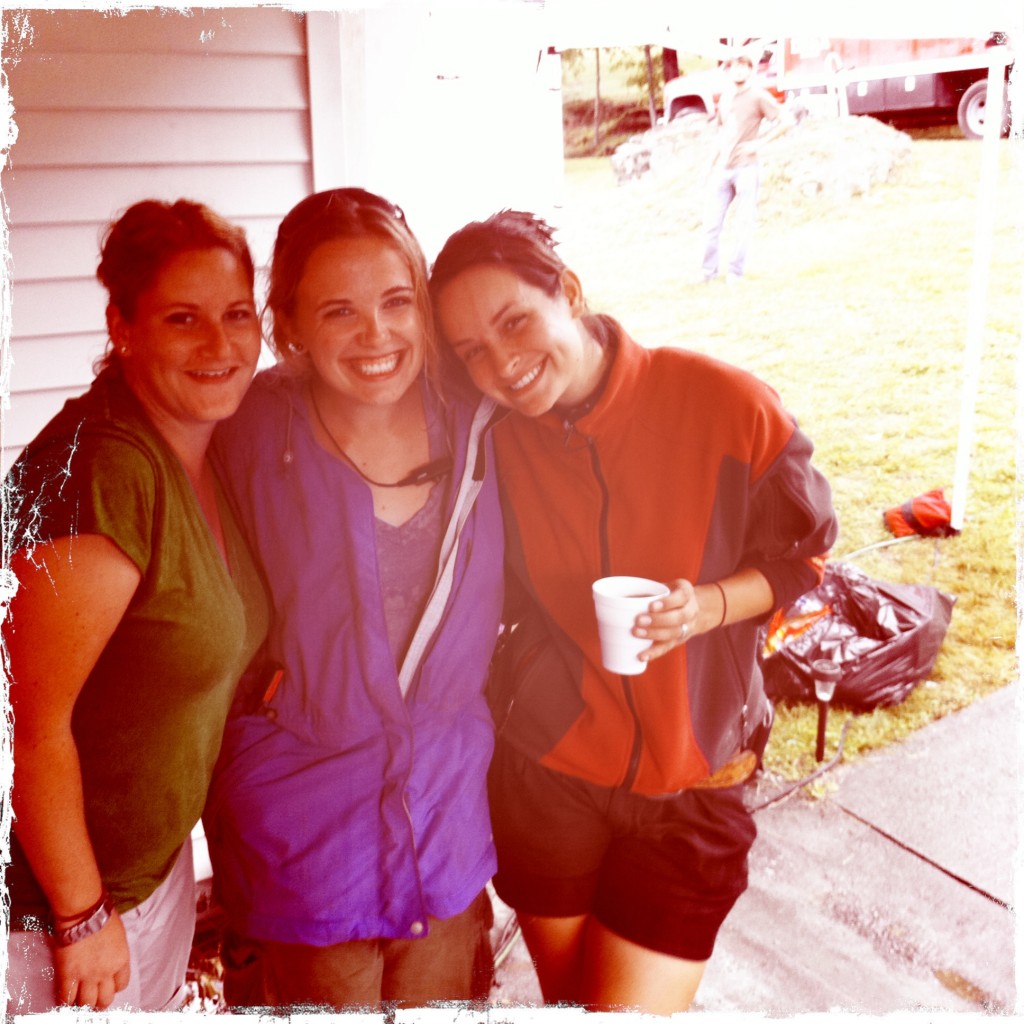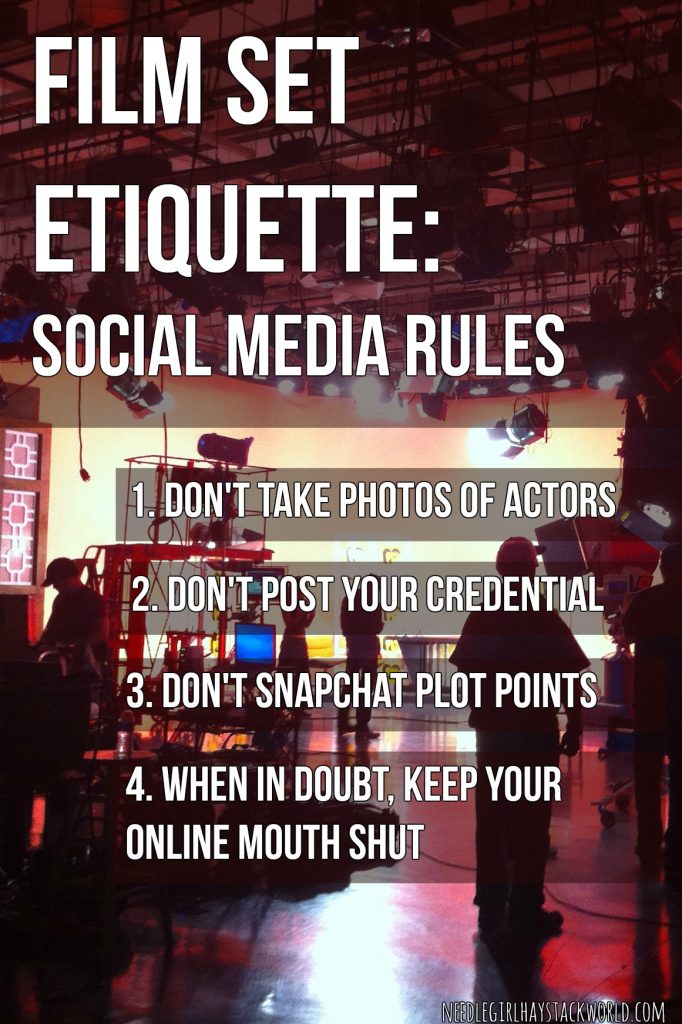Everyone knows amazing or awesome photos/events gain the most traction on social media. When your job happens on a film set, these brag-worthy moments happen frequently. But what are the do’s and don’ts?
If you’re just starting out, it is VITAL that you pay attention to your surroundings, do your job, and forget about social media. In one of my college courses, my professor told us, “You’re entering into the entertainment industry, which means you’re a professional. Never act like a fan, or you will be fired.” Wise words.

Social Media Etiquette on Film Sets: Posting Photos from Set
It’s true, kids: There once was a day when people took photos and didn’t IMMEDIATELY post them online.
In my PA days, I’d occasionally take wide shots of set from my lockup, just so I’d have something to remember those days with. They weren’t for the masses, and that was okay.
Social media is an extension of life now. I constantly see interns or new PAs pulling out their phones the moment anything cool happens, and then immediately posting it on Instagram or Snapchat. Sometimes, this may be fine– but sometimes, it may get you fired.
It’s important to know how to abide by basic social media etiquette on set, so here are guidelines that I’ve adapted for myself over the years. I’m pretty conservative in how much I share for the sake of remaining employed. Some have gotten away with posting more, but that’s their prerogative.
OK: Posting a photo of you on set or with a fellow crew member.
These are by far the most common “on set” photos that appear in social media. They’re fun, they’re cute (look at the three of us– don’t you want to hire us all?!), and they’re also a great networking tool as other freelancers will learn your name and see your face. Keep in mind that the crew you’re on set with will likely also see those postings. If it’s a particularly hectic day and you’re off posing for photos with some extras instead of doing your job, you may not be asked to come back. Be smart. Wait for a moment of downtime to take your photo.
OK: Posting a photo of cool gear or a crazy gear setup.
This is probably the most acceptable type of photo! It celebrates the craft, it appreciates the methodology, it shows that you realize that this is an extra complicated or special setup.
Sometimes OK: Posting a generic photo of the set.
I know several people who work on scripted television series on major networks. They never post generic photos of set — usually, it’s a shot of a sunrise, or the view from set.
The exceptions? This can vary, depending on your position on the film. You’ll sometimes see DPs and directors sharing photos from their latest gig. If you’re a production assistant, be extra cautious. My self-imposed restrictions as a PA: Low-budget indie films, small music videos, or keep it pretty darn generic. And I didn’t post often!
Note: Large film projects give out “photo passes” to the only people that need to be taking photos on set for work purposes only: (1) Still photographer, (2) wardrobe assistants, (3) props department. If you don’t have one of these passes, don’t take pictures. Simple, right?
Rarely OK: Posting a photo of you with a celebrity.
Taking pictures with celebrities while you’re on the job is frowned upon as unprofessional behavior unless (1) you’re an EP, director or DP; (2) you’re an AD, you ran basecamp, and the actors know and love you well, or (3) it’s at the wrap party, the project is over, the actor is totally cool with snapping a souvenir picture, and you see other crew members doing the same.
For example: Dan Marino showed up at the after-party for a live event I was a junior producer for. He was super cool and took photos with anyone that approached him. Knowing he was one of my childhood heroes, my boss egged me on, and now I’m grateful she did.

Never OK: Posting a photo of your credential.
Credentials exist to give the worker bees access and to keep the general public out. If you share a photo of your credential, some random and astute person could potentially copy, print, and laminate it, and waltz right on in. A guy got kicked out of the Super Bowl for innocently, yet stupidly doing this. Don’t make the same mistake.
Never OK: Posting photos of a celebrity on set.
THIS IS A HUGE HAIL NO.
Social Media Etiquette on Film Sets Lesson #2: Name-Dropping
“Just made David Letterman laugh — life made.”
“I don’t usually care about celebrities, but Tom Hanks just gave me a high five…and I might’ve peed my pants.”
This is probably the most common form of bragging amongst my peers. These posts are light-hearted, they make you smile, they make you love that celebrity more, they make you jealous. This is all OK, because you’re shedding positive light on everything and everyone involved. The celebrity likely instigated it, which is also a huge plus.
When Name-Dropping Is NOT Okay
“Just saw ACTOR-NAME snort coke… thumbs up!”
“Dude, ACTRESS-CHICK is not looking good these days.”
“Man, thank God for editors, because DUMB-SINGER can’t string a sentence together.”
I know, I hear you, this is common sense. If someone is oblivious enough to say anything like this on social media, they shouldn’t be in the business anyway. I share these over-the-top examples to make a point: Anything that would potentially disparage the image of a celebrity is NOT worth sacrificing your career for.
We are hired to do one job: Make people look good on camera. We are not hired to expose the latest in celebrity gossip or reveal what’s behind the curtain. If you do, you will be blacklisted immediately, and you could be looking at a lawsuit. If you had an unbelievably negative experience with a famous actor, director, or DP, wait until long after the project is over and keep them anonymous.
Example: I once posted a story about an altercation I had with an actor. The incident had happened two years earlier when I’d posted it, but just in case, I changed the bozo’s name to protect whatever positive image he still retains along with my career.
Note: If you’re working on a well-known television series, the celebrity’s appearance may be part of an unexpected plot reveal and it’s probably best to not say anything.

Location Scouting: generally a good time for photo ops
Other Guidelines
It depends on the show. Social media protocol can vary from set to set. What may be cool on one shoot could get you into trouble on the next. Overall, I find scripted, big-budget projects to be more policed. Random commercials or PSAs, less so. Different showrunners, executive producers, and producers will have their own rules regarding social media. I once worked with a showrunner who freaked out if she saw anyone on the crew taking a photo — even of a sunset!
Should you stop a location contact from taking photos? What should you do when you’re on site and notice the location contact taking photos of the actors, filming, everything? Some people will tackle them outright. My general go-to: Please don’t post those photos on social media. I then try to connect them with my boss, or a producer, who can explain the photo-taking protocol. They can also work out an arrangement for the location to be able to post approved photos in the future (the day the show airs, etc).
If you share an incident online, do it in broad strokes. If you want to write about your on-set experience and are unsure of the ramifications it could have on your career, don’t do it. But if you do, keep as much of the identifying characteristics as anonymous as possible. This includes specific places, names, and the title of the project.
A few words about blogging. It’s a tricky industry to write about. The entertainment industry is pretty loosey-goosey in some respects (drinks with the boss, anyone?), but it is VERY rigid when it comes to “leaks”– discussing characters and plot points, etc. Evan at the Black and Blue and Michael of the Hollywood Juicer both do a great job retelling stories from the set without spilling the giveaway details. While they drop hints about the types of projects they’re working on, they rarely, if ever, mention the project by name. This adds a layer of protection– both for themselves, the actors, and the crew that they’re working with.
Did you sign a non-disclosure/confidentiality agreement? Before you post that photo of the “LETHAL WEAPON XII” props (or divulge the plot line to two of your best friends), recall the massive amounts of paperwork you signed as part of your deal memo. Was a confidentiality agreement among them? If so, you could be looking at serious lawsuits down the line.
When in doubt, keep your online mouth shut.


 I'm Laryssa, and when I'm not working in film or television, I'm attempting to travel -- or I'm here, providing resources for working in film or travel.
I'm Laryssa, and when I'm not working in film or television, I'm attempting to travel -- or I'm here, providing resources for working in film or travel. 










July 28, 2019
Hi,
I’ve been trying to find some information about sharing content from a film set on social media. I’ve found videos and pics from the set of a very popular show on Instagram and Twitter. The photos and videos show the set, characters in costume, and spoilers about the upcoming story line. I’ve tried contacting the show’s producers and actors but I’m sure the messages go unnoticed since it was through direct messenger and they’re not following me. I’ve confronted the people posting these photos and have been harassed to the point where I’ve had to delete my social media accounts. Do you know anything I can do to report this to the right person? Instagram and Twitter aren’t helping. This is a Netflix show. Any help or advice would be appreciated.
June 2, 2020
Very unique content I have found some on Celebrity Insider too”Nene Leakes Explains Why Kandi Burruss Has A Problem With Her — Also Reveals Wendy Williams Has Been Ignoring Her”
January 19, 2022
good
January 19, 2022
Good Information this Blog. If you need Digital flim marking. Please read this Blog.
May 17, 2022
This blog provides good information about Digital film marking. If you need more informative movies and videos, please visit this site.
October 26, 2022
Many people that are fans become professionals in the film and television industries. How do you balance being a fan with all the enthusiasm that goes with that, with doing your job and behaving professionally on set and observing so many guidelines and rules ?
July 25, 2023
The interactivity of blog and article sites sets them apart from conventional media. Readers can engage with authors through comments and social media shares, fostering a dynamic community around each piece of content. This direct communication between content creators and audiences has enhanced the engagement and relevance of online publications.